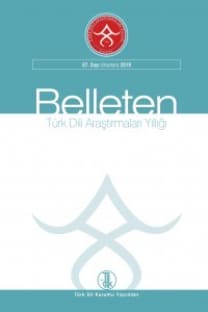m, p, r, s Ünsüzleriyle Yapılan Pekiştirme ve Kuralları Üzerine
Türkçede pekiştirme yapmanın çeşitli yolları vardır. Pekiştirme yapma yollardan biri de m, “p, r, s” ünsüzleriyle sıfatlar üzerinde pekiştirme ön heceli yapılar kurmaktır. Söz konusu ünsüzlerden biriyle yapılan kapalı hece kelimenin başına getirilerek pekiştirme unsuru kurulmuş olur. Türkçe dil bilgisi kitapları konuyla ilgili olarak sadece pekiştirme hecesinin nasıl kurulduğunu söylemekle sınırlı kalmıştır. Söz konusu pekiştirme yapısının dört ünsüzle ilgili kuralları üzerine ise farklı çalışmalarda yorumlar yapılmış ve tartışılmıştır. Ancak bu yorum ve tartışmalar kesin bir sonuca ulaştırılamamıştır. Bu makalede pekiştirme hecesinin dört ünsüze göre durumu ve asıl pekiştirme hecesi ile alternatif pekiştirme hecesi çerçevesinde tartışılarak konu ayrıntılı olarak tartışılmakta neden ve sonuçlara ışık tutulmaktadır
Anahtar Kelimeler:
“m, p, r, s” ünsüzleriyle yapılan pekiştirme, sıfatlarda pekiştirme, pekiştirme hecesi ve kuralları
(On Intensities Done with m, p, r, s Consonants and Their Rules)
In Turkish, there are various ways of forming reduplication. One of the ways to form reduplication is forming structures of reduplicated pro-syllables on adjectives with consonants m, p, r, s. Reduplication element would be formed by bringing the syllable formed with one of the aforesaid consonants at the beginning of the word. Turkish grammar books are limited in the concerned topic by only showing how reduplication syllable is formed. Meanwhile, comments and discussions have been made in different researches on aforesaid reduplication structure’s four consonant rules. However, these comments and discussions have not been concluded accurately. In this article, reduplication syllable’s state regarding four syllables is argued in details within the scope of the main reduplication syllable and alternative reduplication syllables and the causes and effects are cleared
Keywords:
reduplication formed with consonants “m, p, r, s” reduplication of adjectives, reduplication syllable and rules,
- ISSN: 0564-5050
- Başlangıç: 1953
- Yayıncı: Türk Dil Kurumu
